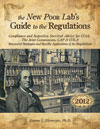Guest Essay
Prepare for Inspection
An excerpt from Dr. Sharon Ehrmeyer's new book, the Poor Lab's Guide to the Regulations
Keep your test site inspection ready!
[EXCERPT From Chapter 8: Preparing for Inspection]
Sharon S. Ehrmeyer, PhD
November 2012
The Clinical Laboratory Improvement Amendments (CLIA) mandate in Subpart Q that all test sites performing nonwaived testing must undergo an inspection every two
years. COLA doesn’t specifically inspect waived testing, but both The Joint Commission and CAP do. Depending on which agency conducts the inspections, the inspectors can be from the Centers for Medicare and Medicaid Services (CMS) or state agents that work with CMS for CLIA compliance, the Joint Commission, CAP, COLA or whatever agency accredits your laboratory.
Regardless of the agency, all inspections are unannounced and focus on essentially the same areas. While being “ready” can’t guarantee a stress-free inspection, it should
be less of a hassle and make you look “good” in the eyes of the inspector. First impressions do count! Make sure to have the requirements from your inspection agency and have the documentation for each readily available for the inspector’s review. Inspections need to take place while the site’s CLIA certificate is still valid. Accreditation agencies have “get inspection ready” tools for test sites to follow.
For laboratories being inspected for CLIA compliance make sure to look at the latest (2004) edition of the “Regulations and Interpretive Guidelines for Laboratories and Laboratory Service” along with the CLIA regulations. Both can be accessed off of the CMS website: http://www.cms.gov/CLIA/03_Interpretive_Guidelines_for_Laboratories.asp#TopOfPage
The Interpretive Guidelines also are referred to as Appendix C of the State Operations Manual and they serve as a companion to the final CLIA (2003) Rule. Through
the document’s Interpretive Guidelines and Probes sections, laboratories are better able to understand how to meet the CLIA requirements and to be aware of what specific
information inspectors will want to see. All CLIA standards are associated with a “D” or deficiency tag. When a laboratory is found in noncompliance with a particular requirement, the surveyor cites the associated “D” number rather than repeating the specific standard.
The Mock Inspection (Section 8.1) that follows is applicable to all inspections (CLIA, The Joint Commission, CAP, COLA, etc.) and will assist you in preparing for
and gathering the appropriate information to successfully meet the inspector. Use this general guideline in addition to your inspection agency’s specific requirements.
Highlights include:
- Documenting general test site information
- Quality Assurance Plans, monitors, method comparisons, accuracy assessments
- Essential personnel records
- Procedure manual requirements, including policies and procedures
- Quality Control Plan, QC evaluation and documentation
- Proficiency testing – enrollment, performance, review
- Reagent, QC, calibrator storage
- Patient test results – critical values, documentation, audit trail to link everything
together - Safety issues – biological, fire, electrical, disaster plan
- Instrument maintenance
- Instrument performance evaluation – accuracy, precision, reportable range, reference

